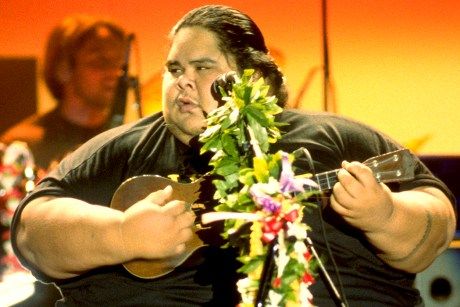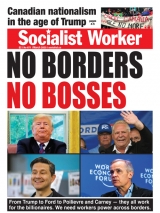Features
You are here
Israel Kamakawiwoʻole and Hawaiian sovereignty

July 18, 2015
June 26 was the 18th anniversary of the death of Hawaiian singer Israel Kamakawiwoʻole. Though he’s best known for a medley of “Somewhere Over the Rainbow/What a Wonderful World,” he was the voice of Hawaiian sovereignty.
Colonization
European colonization decimated the Hawaiian population—which numbered a million people before Captain Cook “discovered” it in 1778. In 1893, US marines supported a coup against Queen Lilil’uokalani, and in 1898 the US annexed Hawaii. As well as eliminating self-representation of the indigenous island population, the US and its Christian missionaries banned the teaching of the Hawaiian language. Ever since then, the indigenous population (10 per cent of the population) have been treated as second-class citizens on their own islands; there is also a Hawaiian diaspora, especially in California.
While the US initially used the islands as a sugar plantation and whaling port, it also militarized Hawai’i. The US Pacific Fleet is based in Pearl Harbour, on the island of Oahu, and during WWII the US declared marshal law throughout Hawai'i and began using the island of Karo’olawe as a training ground and bombing range. More recently Hawai’i has been turned into tourist “paradise”—based on occupied land and appropriated culture.
Sovereignty
In the 1970s a Hawaiian sovereignty movement emerged alongside the anti-war, American Indian Movement and other liberation movements. The first struggles were to stop evictions and defend the land from developers in 1970. In the 1970s groups formed like ALOHA (Aboriginal Lands of Hawaiian Ancestry) to demand reparations, Protect Kaho’olawe ‘Ohana to stop the US from using the island as a bombing range, and Ohana O Hawai’i to demand complete independence.
As Hawaiian activist and professor Davianna Pomaika'i McGregor writes, “Beginning in 1970, a dynamic and sometimes militant grass-roots movement for native Hawaiian rights emerged. Simultaneous with this political movement was a vibrant and creative renaissance of Hawaiian music, dance, language, and culture. A new level of political and cultural consciousness about the history of Hawaiians as a people was popularized in this period. Every strata of the Hawaiian people identified with the political and cultural revival of the Hawaiians as a people.”
In 1978 (the bicentenary of European colonization) a state constitutional convention promoted the preservation of culture and language. In 1993 President Clinton apologized for the 1893 coup (but refused to offer reparations), and in 1994 the military relinquished control of Kaho’olawe (but continues to control much of the islands), and in 1997 a coalition emerged to reclaim the culture of the hula dance.
Song
Israel Kamakawiwoʻole was the most popular voice of this revival. Born on May 20, 1959, three months before Hawaii became a full state of the US, he played his ukulele for family, friends, and on stage in the bar that his parents worked at and managed. His talents grew and eventually his family moved to the island of Mākaha. There, Israel Kamakawiwoʻole and his brother, Skippy, formed The Mākaha Sons of Ni‘ihau group in 1976, with musicians John Koko, Jerome Koko, and Louis "Moon" Kauakahi. It was through this group that their popularity and influence spread.
Both with his group and with his solo career that began in 1990, he used music as a platform to promote Hawaiian independence. His sovereignty work was exhibited through his music by the incorporation of traditional Hawaiian melodies with reggae and jazz, and the direct message of Hawaiian sovereignty in the music itself. Kamakawiwoʻole became an icon and symbol of the Hawaiian sovereignty movement and was one of the influential individuals of its resurgence in the 1990s.
As he sings in Hawai’i ’78, on his 1993 Album Facing Future (the best selling Hawaiian album of all time),
“If just for a day our king and queen
Would visit all these islands and saw everything
How would they feel about the changes of our land?
Could you just imagine if they were around
And saw highways on their sacred grounds
How would they feel about this modern city life?
Tears would come from each others eyes
As they would stop to realize
That our people are in great great danger now
How, would they feel, could their smiles be content, then cry.”
Twenty years later, the movement for Hawaiian self-determination continues. As part of the global spread of Idle No More, Hawaiians rallied on January 16, 2013—the 120th anniversary of the coup—to protect Hawaiian rights and the land on which they are based (including stopping the agribusinesses from genitically modifying and patenting the taro plant that is central to Hawaiian diet and culture).
The music of Israel Kamakawiwoʻole remains an inspiration to this ongoing movement. He may be gone, but his music, his words, and most of all, his dreams still live on in the hearts of millions of native Hawaiians and beyond.
Section:










